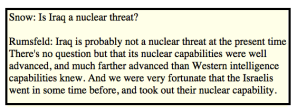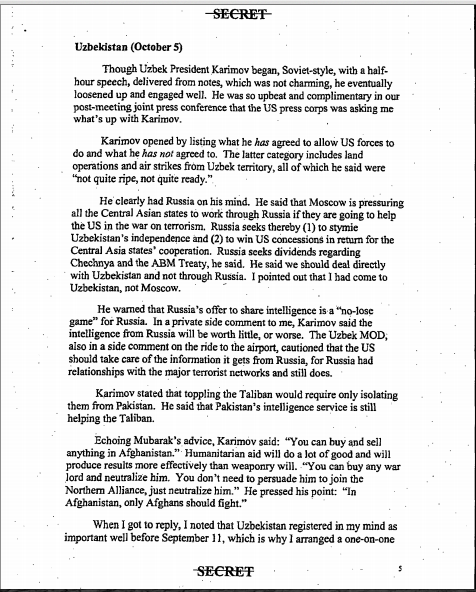Declassified Memo of Rumsfeld’s Post-9/11 Middle East Visit Highlights Logistical Challenges; Unwavering Belief in WMD

No stranger to the region, Rumsfeld served as Middle East envoy under President Reagan. Here Iraqi President Saddam Hussein greets Rumsfeld in Baghdad on December 20, 1983.
Less than one month after the September 11 attacks, Donald Rumsfeld embarked on a coalition building trip to the Middle East, his first visit to the region while serving as Secretary of Defense. Rumsfeld notes in his 2011 memoir Known and Unknown that at the time of his whirlwind October 3-5 visit to Saudi Arabia, Oman, Egypt, Uzbekistan, and Turkey, he knew that CENTCOM commander General Tommy Franks was planning to insert special operations teams into Afghanistan on the nights of October 6 and 7.1 Rumsfeld’s tour was therefore intended to shore up support for the U.S.’ nascent war on terror from the countries surrounding Afghanistan, and to assuage fears that U.S. military action in the region would be a “flash in the pan.”
The National Security Archive recently received Rumsfeld’s long sought Secret October 6, 2001, memo to the President recounting this trip.2 Requested in 2011 and recently released in part on appeal by the Interagency Security Classification Appeals Panel (ISCAP) – portions are still withheld to protect purported foreign government information and U.S. foreign activities – the memo complements previous reporting and provides new insights into planning for the war on terror, in particular the difficulties finding a base for air strikes against Afghanistan.
While Rumsfeld’s trip was ostensibly focused on Afghanistan and the hunt for Osama bin Laden, Iraq must have been in the back of the Secretary’s mind as he assessed Middle Eastern leaders’ willingness to assist the U.S.’ efforts in Afghanistan. On September 12, 2001, three weeks before his Mideast visit, Rumsfeld was already asking President Bush’s war cabinet if the 9/11 attacks didn’t present an “opportunity” to target Iraq.3 And even though President Bush informed National Security Advisor Condoleezza Rice on September 16 that Afghanistan would be the first target in the war on terrorism and that plans for Iraq were being put on hold,4 by September 29, less than a week before his Mideast tour, Rumsfeld had asked the Joint Chiefs of Staff to begin preparing Iraq war options with two objectives: finding WMD and plans for Iraqi regime change.
Rumsfeld visited Saudi Arabia first on October 3. Both American and Saudi camps agreed that the terrorist threat “is especially grave in light of the danger of weapons of mass destruction in the hands of states that sponsor terrorism.” It’s worth noting that the only portions of the Secret memo that remain withheld are excerpts surrounding mention of states supporting WMD. It’s probable this reference concerns Iraq (despite Rumsfeld’s February 11, 2001, appearance on Fox News’ Tony Snow in which he said “Iraq is probably not a nuclear threat at the present time,” and his own September 29 request that WMD evidence be found), however we will have to wait for a future, further release of this memo to be certain.

Transcript from Rumsfeld’s February 12, 2001 appearance on Fox News Live with Tony Snow.
While Rumsfeld reports in the memo that his Saudi visit was a productive one, an October 3 DOD press release notes that immediately after the Saudi visit “The secretary downplayed reports that Saudi Arabia has failed to cut off financial support to terrorist organizations” and that the Kingdom refused to allow strikes on Afghanistan being launched from its bases.
The next day on October 4 Rumsfeld was received by Omani Sultan Qaboos, who vowed his nation’s wholehearted assistance in the U.S.’ war in terror. Qaboos urged Rumsfeld to address the “problems” caused by the Arab news media, primarily Al Jazeera, which promoted “the terrorists points of view.” (This isn’t the only time Al Jazeera would be a potential target of the war on terror; three years later media outlets would report that British Prime Minister Tony Blair talked President Bush out of bombing Al Jazeera headquarters in Qatar on April 16, 2004, a claim the U.S. government called “outlandish” despite its repeated criticisms of the network and earlier bombing of Al Jazeera outlets in Iraq and Afghanistan) After the Mideast trip, on October 6, 2001, CNN reported Rumsfeld had discussed the possibility of “staging” U.S. aircraft at air bases in Oman, but a senior official traveling with Rumsfeld told reporters this idea was later scrapped.
 Later in the day on October 4 Rumsfeld had what he described as a “lively” visit with Egyptian president Hosni Mubarak. Securing Egyptian support was key for the Afghanistan campaign, Rumsfeld knew, because Egypt controlled the Suez Canal, which could provide U.S. aircraft carriers passage from southwest Asia to the Mediterranean. During their discussion Mubarak was adamant that the U.S. focus in the war on terror should be on resolving the Israeli-Palestinian conflict rather than direct aggression. Rumsfeld also noted that immediately after the 9/11 attacks Mubarak made the “unhelpful” comment that Egyptian cooperation in any U.S. campaign would depend on what proof the U.S. could provide about bin Laden’s involvement in the 9/11 attacks, though Mubarak did not reiterate the sentiment in his meeting with Rumsfeld.
Later in the day on October 4 Rumsfeld had what he described as a “lively” visit with Egyptian president Hosni Mubarak. Securing Egyptian support was key for the Afghanistan campaign, Rumsfeld knew, because Egypt controlled the Suez Canal, which could provide U.S. aircraft carriers passage from southwest Asia to the Mediterranean. During their discussion Mubarak was adamant that the U.S. focus in the war on terror should be on resolving the Israeli-Palestinian conflict rather than direct aggression. Rumsfeld also noted that immediately after the 9/11 attacks Mubarak made the “unhelpful” comment that Egyptian cooperation in any U.S. campaign would depend on what proof the U.S. could provide about bin Laden’s involvement in the 9/11 attacks, though Mubarak did not reiterate the sentiment in his meeting with Rumsfeld.

umsfeld (left) and Uzbekistani President Islom Karimov speak to reporters in Tashkent, Uzbekistan. Photo by Sgt. 1st Class Kathleen T. Rhem, USA.
Days before his October 5 visit to Uzbekistan, Rumsfeld was quoted in an October 2, 2001, DOD press release saying Uzbekistan would be an ideal staging ground for “any anti-terrorist coalition military strikes.” On the day of the visit, however, Uzbekistan President Islam Karimov agreed to allow U.S. troops to use one of its air bases for humanitarian purposes, but not for air strikes, noting “In Afghanistan, only Afghans should fight.” Karimov also informed Rumsfeld that Russia was pressuring all Central Asian nations to work through Moscow in the hopes of obtaining U.S. concessions for Central Asia’s cooperation in the coalition.
Rumsfeld met with Turkish Prime Minister Bulent Ecevit, the Foreign and Defense Ministers and the Chief of the General Staff later on October 5 for his final round of Mideast talks. The Turks insisted that the Taliban were a menace to Islamic society, and that Turkey would cooperate with the U.S. to address the Taliban threat even after the disposal of Osama bin Laden. The Turks also addressed concerns about Russia’s role in the coalition against terror, namely that the Russians’ intent was to position Russian troops in an effort to isolate Turkey from the Central Asian states, to undo the Caspian Sea-Turkey oil pipeline, “to win a free hand in Chechnya and to launch military operations in Georgia.” Rumsfeld reminisced after their meeting that the Turks were “superb” allies, and “Would that all our NATO friends worked with us as Turkey does.”
While the short trip highlighted a host of logistical problems for air strikes against Afghanistan, the U.S. war with Afghanistan went ahead on October 7, two days after Rumsfeld’s return to Washington. The first strikes were launched from submarines based in the Arabian Sea, U.S. aircraft carriers USS Carl Vinson and USS Enterprise, and USAF bombers launched from Diego Garcia.
It remains to be seen what further insights can be gleaned from future declassifications of this memo, in particular what, if any, redacted portions concern arguments in favor of Iraqi connection to WMD and how they might have effected President Bush’s November 21, 2001, instruction that Rumsfeld confer with General Franks to determine how to “protect America” by removing Saddam Hussein from power, and, if possible, to do it in a way that wasn’t “noticeable.”5
1. [Rumsfeld, Donald, Known and Unknown: A Memoir, New York: Sentinel, 2011, p.379]↩
2. [The memo is one of the many posted on Rumsfeld’s website, www.rumsfeld.com, to supplement the publication of his memoir, Known and Unknown. Instead of using the FOIA to obtain these documents, Rumsfeld used a provision of the President’s Executive Order on Classification that allows presidential appointees to jump the line and request declassification of the documents they created during their tenure.]↩
3. [Woodward, Bob, Plan of Attack., New York: Simon & Schuster, 2004, p.25]↩
4. [Woodward, Bob, Plan of Attack, New York: Simon & Schuster, 2004, p.26]↩
5. [Woodward, Bob, Plan of Attack, New York: Simon & Schuster, 2004, p.2]↩



Reblogged this on Nick Robson's Blog.